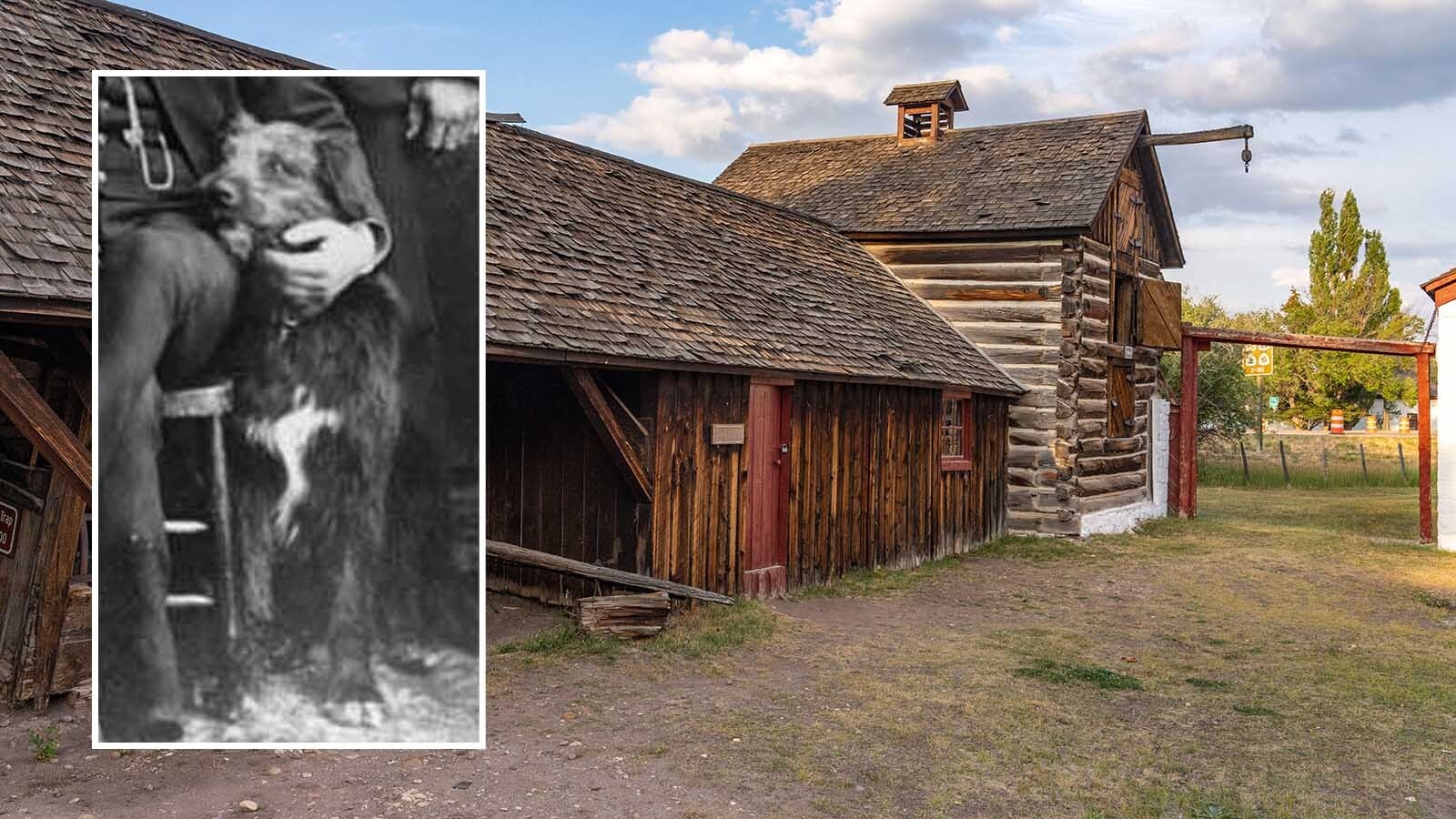Three times, early pioneers of Wyoming have been said to have seen an ancient ship of death, a fully crewed vessel that came like the mist down the Platte River.
It brought with it a horrifying vision to all who saw the spectral vision.
The Cheyenne Bureau of Psychological Research was said to have recorded these sightings directly from the eyewitnesses themselves.
Author Victor Gaddis claimed to have unearthed these first-person accounts in 1948 that had been lost to the public for decades. The story has since been repeated over the last century, invoking visions of a ghostly ship haunting Wyoming.
The Trapper
The first sighting of this terrifying ship was reported by Leon Webber to the Cheyenne Bureau of Psychological Research. He was an Indian scout, and in 1862 was building a log cabin for his future bride.
The site he had chosen was located on the Platte River 6 miles southeast of the present site of the Guernsey Dam.
It was late afternoon Sept. 12, 1862, when Webber took a break from his chores to glance up stream on the North Platte. He reported being startled to see a gigantic ball of fog riding on the surface of the water, near the middle of the stream.
Webber ran toward the strange sight and stopped at the edge of the river, stunned by what he was witnessing. His dog whined and paced beside the bank, clearly distressed.
Out of the swirling mist, an ancient sailing vessel slowly took shape. The mast, spars and sails seemed to be sheeted with sparkling frost.
Faint sounds of rowing and commands floated through the air to the stunned trapper, but even these sounds disappeared as the ship’s ghostly crew came into view. Webber could see the sailors standing in a tight circle, unmoving on the ice-covered deck. Their blank faces stared at him without blinking.
The ship seemed to hover on the Platte and the minutes slowed down. Webber could only hear his own heartbeat and the soft whines of his dog. Even the birds had gone silent at the apparition suspended in their midst.
The sailors stepped aside, revealing a large square of frosty canvas spread upon the deck.
A shiver ran down Webber’s spine as he realized that on the canvas was the corpse of a girl. She was also encased in the frost which glittered in the rays of the afternoon sun.
The ship suddenly veered closer and Webber recognized the corpse as that of Margaret Stanley, his betrothed.
“Margy!” a panicked Webber shouted.
He was about to launch himself into the river when the death ship instantly vanished.
He remained upon the bank until long after sunset, but saw nothing more of the strange phenomenon.
Years later, Webber told investigators that because of this ship, he had left Wyoming earlier than planned.
To his horror, upon arriving at the Stanley home he learned of his beloved’s death. She had died the same afternoon he had witnessed the spectral ship of death upon the waters of the Platte.

The Rancher
From its ghostly harbor, the phantom vessel again sailed in the autumn of 1888, and this time appeared to Gene Wilson. He was a cattleman who, according to Gaddis, later told the Cheyenne Bureau of Psychological Research the details of his encounter.
Wilson was rounding up some stray cattle along the Platte, 10 miles east of Casper. His dog, who had run ahead, began barking wildly, looking at something on the river. Wilson’s horse balked at going closer and so the rancher was forced to dismount, tie his horse to a nearby scrub wood and approach on foot.
Squinting into the sun and at the swiftly running water, Wilson’s nerves suddenly tingled with shock.
Near the middle of the stream was a full-rigged sailing vessel under full sail. It was anchored in place and did not move. It glittered with ice in the full Wyoming sun.
Without taking his eyes off the strange apparition, Wilson walked up the bank to get a closer look. He saw nine sailors working under the stern eye of the captain but could barely hear the faint sounds.
The captain stood with his arms folded and gave orders to his men without turning his head.
“Let down,” said the captain without a sign of animation.
At the captain’s command, a square of icy canvas was lowered to the deck by four ropes attached to its corners. Lying upon the canvas and covered with another piece of frost-laden sailcloth was a corpse.
As the sheet came to rest upon the deck, one of the silent sailors grasped a corner of the sheet, drew it aside and revealed the face of a woman. Despite the frightfully burnt and scarred face, Wilson instantly recognized his wife.
Overcome with terror, he screamed and covered his eyes, stumbling back from the terrible sight. In that split moment of dismay, the ship had vanished.
Shaken, Wilson rose and remounted his horse. Abandoning his cattle, he rushed home to his wife.
Topping a hill a quarter of a mile west of his house, his heart stopped beating and his blood froze in his veins. His home was in ashes.
Spurring his horse to a run, he scanned the smoldering embers, frantically calling to his wife. Receiving no reply, he ran toward the river, frantically searching for her.
That’s where he stumbled upon the remains of his wife. She had apparently run toward the Platte, hoping to extinguish the flames engulfing her.
As he gathered her into his arms, he saw that her beloved face was scarred by burns.

The Witness
The death ship’s last recorded appearance was on the afternoon of Nov. 20, 1903.
Victor Heibe told the Cheyenne Bureau of Psychological Research that he was chopping up a fallen tree on the riverbank near his home at Bessemer Bend when the unthinkable happened.
Several months before, he had given testimony on behalf of his good friend, Thomas Horn, who was on trial for murder in the criminal court at Cheyenne.
Despite Heibe’s efforts, Horn had been convicted and sentenced to hang. Much to Heibe’s relief, the condemned man managed to escape from the jail with another prisoner; however, Heibe was unaware at the time that Horn had been recaptured.
Pausing in his work to light his pipe, Heibe glanced up the river and noticed a huge ball of fog apparently resting on the surface of the water. The misty mass was slowly moving down the stream but not as fast as the current was flowing.
The sounds of faint voices came from the approaching fog-ball. As the mist drew nearer, its form shifted, becoming an ancient sailing vessel under full sail. It moved slowly, with every inch of its surface covered with gleaming ice.
While Heibe watched spellbound, a large sheet of frosty canvas was lowered in front of the sailors on the deck.
"All right,” said one voice distinctly, "but I am telling you that you are hanging an innocent man.”
“That,” came a second voice in reply, “is not for us to determine. You were tried and convicted for the murder, and it is our duty to ferry you across. Men, do your duty."
By this time the vessel, slowly moving inshore, had reached a point about 20 feet from Heibe. The sheet of canvas was raised to its former position among the sails revealing a scene of horror on the phantom deck.
On the forward deck there was an icy gallows. From the cross-arm hung the body of a man.
As the body swayed to and fro from the rocking of the ship, it turned so that Heibe gazed directly into the face. It was the face of his dearest friend, Tom Horn.
Heibe stumbled down the riverbank, shouting in disbelief. The icy ship slowly and silently returned to the middle of the stream and faded from view.
Hiebe rushed to town and learned the news. Horn had been hanged in the jail yard at Cheyenne on the afternoon of the same day.
“Three times the phantom ship of the Platte, under sail and coated with glittering ice, has emerged from out of the vasty deep,” wrote Gaddis. “When will it again appear with its tale of gruesome tragedy?”

The Bermuda Triangle Twist
The story of the Wyoming Ghost Ship appeared in the first edition of the Fate magazine in spring 1948. Fiction writer Gaddis co-founded the magazine and wrote nearly half the content, some under pseudonyms. On page 112, “Wyoming’s Ship of Death” made its debut.
Over the years, research has been done attempting to verify the story of the Wyoming Ghost Ship, including by the Committee for Skeptical Inquiry (CSI), the organization that asserts a mission of science and reason.
Gaddis had claimed that the eyewitness accounts were recorded by the Cheyenne Bureau of Psychological Research; however, CSI found no evidence that this organization ever existed.
There is also no historical record of either the trapper or the friend of Tom Horn. There was a widower by the name of Gene Wilson, according to Joe Nickell, senior research fellow of CSI, but no evidence that he lost his wife in a fire.
Gaddis himself is not considered a credible witness by either historians or scientists. He began his writing career as an author of pulp fiction and journalist.
Over his career, he helped promote belief in flying saucers, spontaneous human combustion and poltergeists. But his most notable achievement was coining the name the Bermuda Triangle for a large section of the Atlantic Ocean where ships and planes have disappeared under mysterious circumstances
His first use of the term Bermuda Triangle was in an article for an adventure magazine called Argosy in 1964. In this article, he promoted the view that some kind of paranormal phenomenon, as opposed to storms or other ordinary mishaps, was responsible for the disappearances.
Gaddis' statements on the Bermuda Triangle and spontaneous human combustion have been criticized by skeptics for being inaccurate and misleading. Gaddis has also drawn strong criticism for ignoring possible natural explanations and inventing mysteries where none exist.
As for Wyoming’s Ghost Ship, though it has been debunked by historians, it has found a place in Wyoming’s lore and will continue sailing the Platte River in the nightmares of Wyomingites.
Jackie Dorothy can be reached at jackie@cowboystatedaily.com.





